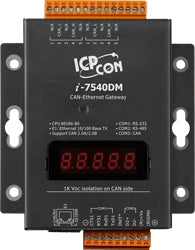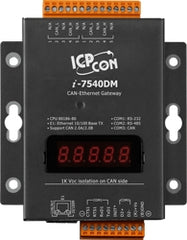

I-7540DM Ethernet to CAN Bus Gateway (Metal Case)
- £303.00
- £303.00
- (-0%)
- Unit price
- per
CAN Bus to Ethernet Gateway (Metal Casing)
Subtotal:
£303.00
Couldn't load pickup availability
Free Shipping
Free standard shipping on orders over £500
Free Returns
30 Day Money Back Guarantee
Description
xThe I-7540D series are CAN to Ethernet converters, and are usually applied as an Ethernet to CAN/RS-232/485 Device Servers. They support socket access functions and virtual COM port technology which helps users to get the CAN, RS-232, RS-485 data via virtual COM port. The I-7540D series also provides transparent mode, which enables CAN networks to be coupled together over the Internet/Ethernet, whereby remote monitoring and control is possible. By the features of tiny operating system, protocol independence, small casing and flexibility, it is able to widely fit various RS-232, RS-485 and CAN applications, which may be based on private RS-232 protocol, private CAN protocol, Modbus protocol, CANopen protocol, DeviceNet protocol or J1939 protocol.
Features
x- 80186-80 Embedded CPU, or compatible
- Ethernet Protocols, TCP,UDP,IP,ICMP,ARP
- 10/100 Base-TX Ethernet Controller
- Reloadable Operating Software
- Message transmitted by using TCP/IP protocol
- Diagnostics
- COM driver support interrupt & 1K QUEUE Input & Output buffer
- Support one RS-232 port, one RS-485 port and one CAN port
- 2500Vrms photo-isolation protection on CAN side.
- Jumper select 120Ω terminator resistor for CAN channel
- Phillip 82C 250/251CAN Transceiver
- Support both CAN specification 2.0A and 2.0B.
- Max transmission speed up to 1M bps for CAN and 115.2kbps for RS-232 & RS-485
- Max transmission distance of CAN over 1000m (follow CAN specification)
- Built-in self-tuner ASIC controller on RS-485 port
- 7-segment LED display.
- Software configurable CAN and RS-232 communication parameters
- Firmware updated from COM1 or Ethernet port
- Support Web Configuration
- Support maximum 25 Ethernet clients connection
- Support for Virtual COM technology
Specifications
x| Model Name | I-7540D | I-7540DM |
| Hardware | ||
| EEPROM | 16 KB; Data retention: 40 years; 1,000,000 erase/write cycles | |
| CAN Interface | ||
| Controller | NXP SJA1000T with 16 MHz clock | |
| Transceiver | NXP 82C250/NXP TJA1042 | |
| Channel number | 1 | |
| Connector | 2-pin screwed terminal block (CAN_L, CAN_H) | |
| Baud Rate (bps) | 10 k, 20 k, 50 k, 125 k, 250 k, 500 k, 800 k, 1 M (allow user-defined baud rate) | |
| Isolation | 1000 VDC for DC-to-DC, 2500 Vrms for photo-couple | |
| Terminator Resistor | Jumper for 120 Ω terminator resistor | |
| Specification | ISO-11898-2, CAN 2.0A and CAN 2.0B | |
| UART Interface | ||
| COM 1 | RS-232 | |
| COM 1 Connector | 5-pin screwed terminal block (TxD, RxD, RTS, CTS, GND ) | |
| COM 2 | RS-485 (Self-turner inside) | |
| COM 2 Connector | 2-pin screwed terminal block (DATA+, DATA-) | |
| Baud Rate (bps) | 110, 150, 300, 600, 1200, 2400, 4800, 9600, 19200, 38400, 57600, 115200 | |
| Data bit | 7, 8 | |
| Stop bit | 1 | |
| Parity | None, Even, Odd | |
| Ethernet Interface | ||
| Controller | 10/100Base-TX Ethernet Controller (Auto-negotiating, Auto_MDIX) | |
| Connector | RJ-45 with LED indicator | |
| Power | ||
| Power supply | Unregulated +10 ~ +30 VDC | |
| Protection | Power reverse polarity protection, Over-voltage brown-out protection | |
| Power Consumption | 2.5 W | |
| Mechanism | ||
| Installation | DIN-Rail | Wall Mount |
| Dimensions(W x L x H) | 72mm x 122mm x 33mm | 102mm x 125mm x 28mm |
| Environment | ||
| Operating Temp. | -25 ~ 75 ℃ | |
| Storage Temp. | -30 ~ 80 ℃ | |
| Humidity | 10 ~ 90% RH, non-condensing | |
Technical
xApplications
xRelated Products
Example product title
- £303.00
- £303.00
- (-0%)
- Unit price
- per
Example product title
- £303.00
- £303.00
- (-0%)
- Unit price
- per
Example product title
- £303.00
- £303.00
- (-0%)
- Unit price
- per
Example product title
- £303.00
- £303.00
- (-0%)
- Unit price
- per
Example product title
- £303.00
- £303.00
- (-0%)
- Unit price
- per
Example product title
- £303.00
- £303.00
- (-0%)
- Unit price
- per
Example product title
- £303.00
- £303.00
- (-0%)
- Unit price
- per
Example product title
- £303.00
- £303.00
- (-0%)
- Unit price
- per
Example product title
- £303.00
- £303.00
- (-0%)
- Unit price
- per
Example product title
- £303.00
- £303.00
- (-0%)
- Unit price
- per
Recently Viewed Products
Example product title
- £303.00
- £303.00
- (-0%)
- Unit price
- per
Example product title
- £303.00
- £303.00
- (-0%)
- Unit price
- per
Example product title
- £303.00
- £303.00
- (-0%)
- Unit price
- per
Example product title
- £303.00
- £303.00
- (-0%)
- Unit price
- per
Example product title
- £303.00
- £303.00
- (-0%)
- Unit price
- per
Example product title
- £303.00
- £303.00
- (-0%)
- Unit price
- per
Example product title
- £303.00
- £303.00
- (-0%)
- Unit price
- per
Example product title
- £303.00
- £303.00
- (-0%)
- Unit price
- per
Example product title
- £303.00
- £303.00
- (-0%)
- Unit price
- per
Example product title
- £303.00
- £303.00
- (-0%)
- Unit price
- per
- Choosing a selection results in a full page refresh.

